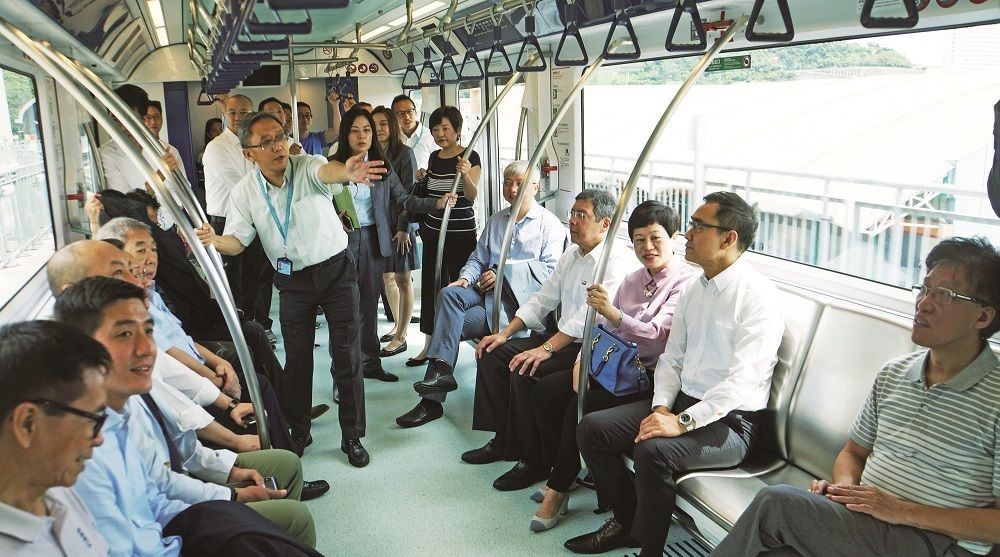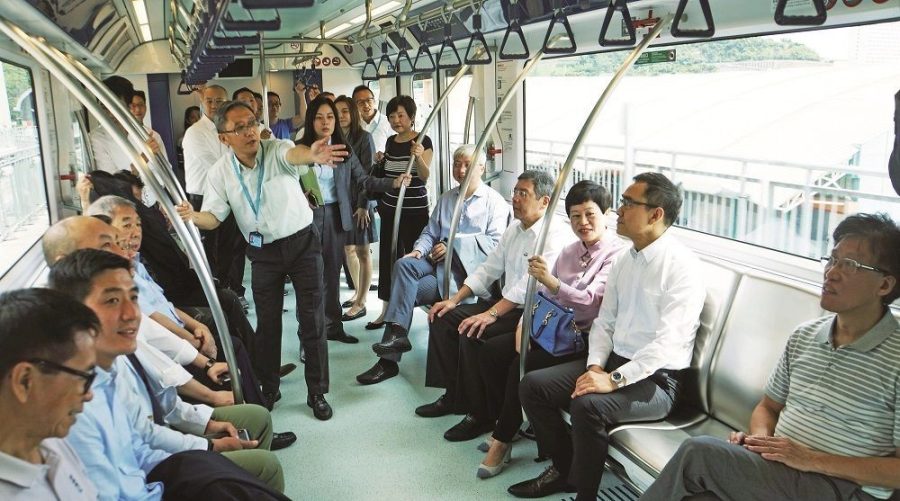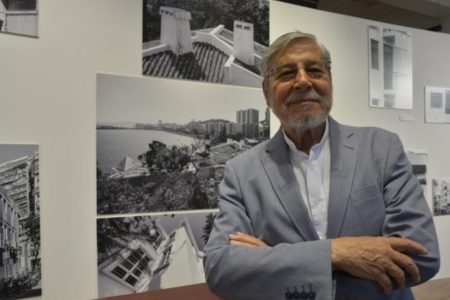Secretary for Transport and Public Works Raimundo do Rosário on Monday invited lawmakers to take their first ride on the Light Rail Transit (LRT) system, according to a statement by the Transport Infrastructure Office (GIT).
The ride included the LRT Taipa line’s depot in Cotai. The system is slated to come into service later this year.
According to the statement, 22 members of the Legislative Assembly (AL) — which currently has 32 members after chief executive candidate Ho Iat Seng resigned from the legislature early this month — joined Monday’s ride.
The statement did not list the 22 legislators who took part in the LRT trip.
In the morning, the delegation from the legislature went to the Taipa Ferry Terminal station – the eastern terminus of the LRT Taipa section, where they visited the station’s internal facilities and also tried out the ticket gates, according to the statement.
After visiting the station outside the Taipa Ferry Terminal in Pac On, the delegation took a ride on a LRT train from the station for a trip to the western terminus of the Taipa section at Ocean Gardens before travelling to the depot, which is located opposite Wynn Palace, according to the statement.
Each LRT train consists of two or four carriages, with each carriage carrying up to 100 passengers, according to the GIT website.
Visual barrier for birds
On the train, LRT staff briefed the delegation on details of the LRT operation, including the design of the LRT carriages and the stations in the Taipa section, the LRT driverless system, the system’s visual barrier installed for migratory birds in the Cotai Ecological Zone, as well as the points where the Taipa section will later link up with the future Barra station and Seac Pai Van section, according to the statement.
The Cotai Ecological Zone, covering an area of 55 hectares (0.55 square kilometres), is located on the western waterfront of Cotai near the Lotus Flower Bridge border checkpoint.
The government has said that the section connecting Taipa and Barra — via Sai Van Bridge — is expected to come into service in 2024. The ongoing Taipa-Barra LRT section project, including the Barra station construction on the southernmost tip of the peninsula — is budgeted at 4.5 billion patacas. “Barra” is Portuguese for “harbour entrance”. The Chinese name of the station is Ma Kok – due to the nearby Ma Kok (A Ma) Temple.
The government said earlier this year that it will invite bids for the construction of the Seac Pai Van section in the third quarter of this year. The 1.5-kilometre-long section will connect the still under-construction Cotai hospital — officially known as Cotai Healthcare Complex — and the Seac Pai Van public housing estate in Coloane. The station outside the Cotai hospital will have a footbridge connected to the Lotus checkpoint station of the Taipa section for LRT passengers to walk between the two stations (to transfer between the Taipa section and Seac Pai Van section).
The LRT trains will run daily from 6 a.m. to 1 a.m., according to the GIT website.
Operations control centre
After the train ride, the delegation members visited the operations control centre of the LRT depot, where LRT staff briefed them about the centre’s operation and the daily tests of the LRT operation, according to the statement.
During their visit, the legislators asked questions such as the LRT fare system, the arrangements for passengers to transfer between the LRT system and the public bus network, and the LRT operation under adverse weather conditions, the statement said.
Government still studying fare system
Rosário told the lawmakers, according to the statement, he was confident that the LRT Taipa section will come into service this year. The
policy secretary said that the government is still studying the LRT fare system, pledging that the government will ensure a smooth connection for passengers between the future LRT system and the public bus network.
According to the Macau Post Daily, the government has still to announce the LRT fares and the date of the operational start of the LRT Taipa section. However, the government has repeatedly reaffirmed that the LRT Taipa section will come into service in the second half of this year. Early this month, Rosário told reporters that the government expected the Taipa section to come into service on December 19 at the latest — i.e. the day before the 20th anniversary of Macau’s return to the motherland.
The Taipa section, which includes Cotai, is 9.3 kilometres long and will have 11 stations. The LRT Taipa section will be operated by Hong Kong’s MTR Corporation at least during the first five years.
The government has pledged that the total cost of the LRT Taipa section, including the construction, the rolling stock and the setting-up of the system, will not exceed the previously budgeted amount of 11 billion patacas.
Ticket gates issue
Meanwhile, in a post on his Facebook page on Monday, non-establishment lawmaker Sulu Sou Ka Hou, who joined Monday’s LRT trip, quoted GIT officials as saying during the trip that due to an agreement signed before 2014 between the local government and Mitsubishi Heavy Industries – the supplier of Macau’s LRT system and trains, LRT passengers could not go through ticket gates directly with their Macau Pass cards, instead they would need to always buy tickets using cash or Macau Pass cards before going through the ticket gates, at least initially after the LRT Taipa section comes into service. According to the post, GIT officials told the lawmakers that the future government-owned LRT company “would solve this problem”






